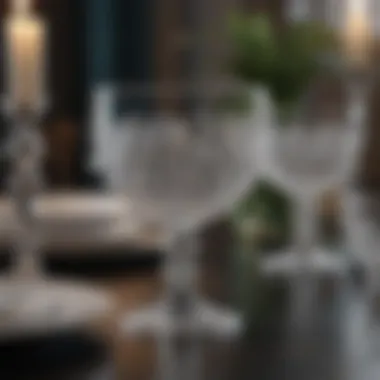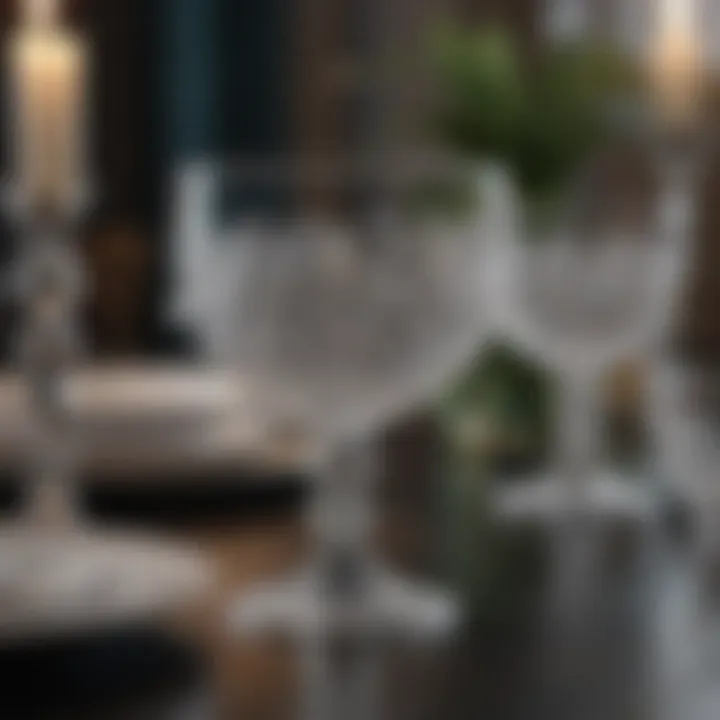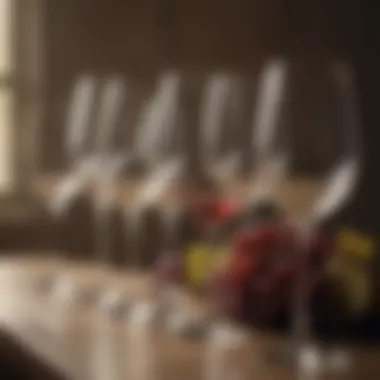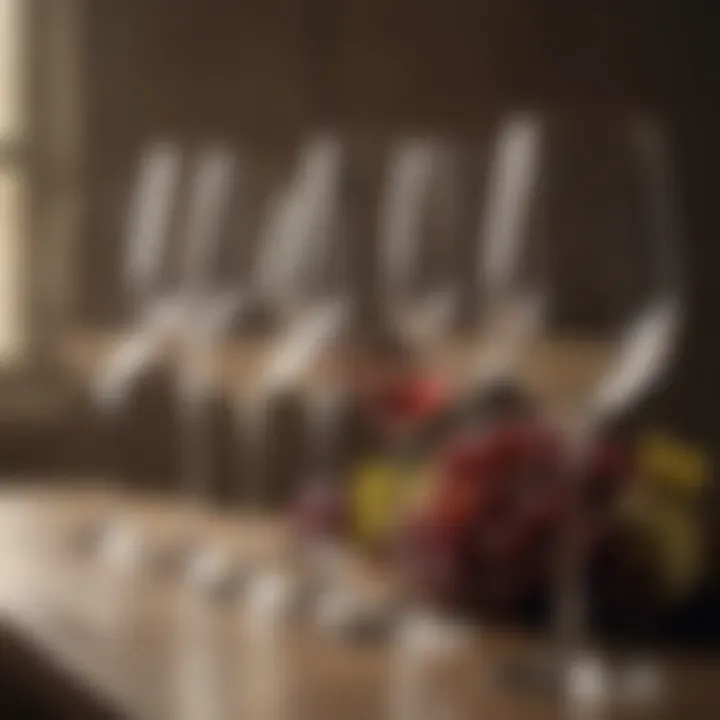The Art of Glassware in Table Setting


Intro
Setting a table is like painting a canvas; each element contributes to a masterful creation. Among these, glassware plays a pivotal role, enhancing not just the aesthetic appeal but also the practical functionality of any dining experience. Whether one is hosting an intimate dinner party or a large festive gathering, the choice of glassware matters immensely. Understanding the type of glassware to choose and the manners of displaying it can elevate an ordinary meal into a lavish feast that speaks volumes about your attention to detail.
In this article, we will journey through the intricate world of glassware, examining its various types and uses. We will share tips about how to carefully select and arrange glassware, ensuring not just elegance but also harmony with the overall table setting. By doing so, we will empower readers to enhance their skills in setting a table worthy of admiration.
The discussion will traverse through different dining contexts, showing how glassware serves not just as vessels for drinks, but also as significant design elements that can make or break the dining ambiance. Every detail, from the choice of a delicate wine glass to the robustness of water tumblers, plays a role in crafting a memorable occasion.
Preamble to Glassware in Table Settings
A well-set table transcends mere functionality; it embodies artistry, culture, and tradition. Glassware serves as an essential component in this tableau, accentuating the overall aesthetic while fulfilling practical needs. By integrating a variety of glass types into dining, one can elevate the experience from ordinary to extraordinary. Here, we take a closer look at the significance of glassware and how it plays a vital role in table settings.
Historical Context
The use of glass in dining dates back to ancient civilizations. From the opulent crystal chalices of the Roman banquets to the delicate wine glasses crafted in Venetian glass workshops, history demonstrates how glassware reflects societal values. Each era and region has its unique styles—think of the handmade Murano glass from Italy or the colorful glass pieces from the 17th-century Netherlands.
Historically, glassware was often a symbol of social status, with finely crafted pieces reserved for the elite. As glass-making techniques evolved, availability increased. Today, the diversity of glassware mirrors global influences, through which culture not only meets function but also embraces design.
Importance of Glassware in Dining
Glassware is much more than a vessel for beverages; it sets the tone for the entire dining experience. The choice of glass can profoundly influence the ambiance of a meal. Here are some pivotal aspects to consider:
- Enhances Aesthetics: The right glass enhances the visual appeal of both the table and the beverage itself. Whether it’s a crystal-clear wine glass catching light or a handcrafted tumbler offering texture, glassware contributes significantly to creative table designs.
- Influences Flavor Perception: Different shapes and sizes of glassware can affect how we perceive flavor and aroma. A wide-bowled red wine glass allows the wine to breathe, releasing its complex aromas, while a narrower flute captures the effervescence of champagne.
- Encourages Conversation: The act of toasting, clinking glasses, and sharing drinks naturally fosters interaction. When guests feel that they are served in exquisite glassware, it invites a more engaging and sophisticated dialogue.
Types of Glassware
Glassware serves as more than just a vessel for drinks; it enhances the overall experience of dining. Understanding the different types of glassware can significantly impact the aesthetic appeal and functionality of a table setting. Choosing the right glass can create a certain atmosphere and elevate the presentation of the meal. Properly selected glassware not only complements the food being served but also aligns with the theme of the event.
Stemware: The Classic Choice
Stemware typically includes various types of glasses that can create an air of sophistication at any table setting. Known for their elegant designs, these vessels are considered ideal for formal dining occasions.
Red Wine Glasses
Red wine glasses are specifically designed to enhance the flavors and aromas of red wines. The bowl of these glasses is generally round and wide, allowing the wine to breathe and develop its bouquet. A key characteristic of red wine glasses is their larger size, promoting aeration. This aspect makes them a beneficial choice in settings where merits of wine tasting are acknowledged. However, one downfall is their fragility, which requires careful handling during events.
White Wine Glasses
In contrast to red wine glasses, white wine glasses are typically slimmer, with a narrower bowl. This design serves to preserve the cooler temperature of white wine. A notable feature is how they guide the wine towards the tip of the palate, enhancing the crispness. This characteristic makes white wine glasses a popular choice for summer gatherings, yet their sleek build can render them less sturdy, leading to the risk of breakage in more casual settings.
Champagne Flutes
Champagne flutes stand out with their tall and slender design, making them perfect for sparkling wines. The elegant silhouette not only looks attractive but also keeps the bubbles intact for longer. This unique feature highlights their role during celebratory events, as their design amplifies the visual appeal of the drink. However, some individuals find the narrow opening less beneficial for savoring the aroma, which is a potential trade-off.
Tumblers for Versatility
Tumblers are another staple in glassware, celebrated for their versatility. These glasses can adapt to various beverages, from mixed drinks to non-alcoholic refreshments, making them suitable for any setting.
Highball and Lowball Glasses
Both highball and lowball glasses provide distinct uses in diverse contexts. Highball glasses are known for their tall, straight structure, making them ideal for cocktails mixed with soda or tonic. On the contrary, lowball glasses, with their shorter stature, are better for stronger drinks served neat or on the rocks. Their main advantage lies in their adaptability, as they can be used for a myriad of drinks, but their similar shapes can sometimes cause confusion among guests.
Rock Glasses
Rock glasses, also known as old-fashioned glasses, are characterized by their robust design, usually short and squat. This makes them perfect for sipping stronger spirits. The hefty feel of rock glasses gives them an air of permanence and quality, encouraging the enjoyment of slower-paced drinking. However, their structure can limit use to only particular types of beverages, which may diminish their versatility in a broader setting.
Water Tumblers
Water tumblers are essential for any table setting, ensuring hydration remains accessible throughout a meal. The key feature here is their straightforward design—designed to hold a generous amount of water without fuss. This makes them a beneficial choice for everyday dining and special occasions alike. Their practicality, however, sometimes leads them to be seen as less stylish, an opinion that varies widely.


Specialty Glasses
Specialty glasses add a unique flair to the table setting, each serving a specific purpose while simultaneously elevating the overall aesthetic.
Cocktail Glasses
Cocktail glasses, often recognized by their distinctive shape, are designed to hold mixed drinks like martinis. The wide bowl allows for creative garnishing and presentations, making them an exciting choice for any cocktail lover. They bring a touch of glamour, making them a staple in social gatherings. However, their delicate structure often requires careful handling to prevent spills or breakages.
Beer Mugs
Beer mugs are a testament to casual gatherings, bringing a sense of camaraderie to any table. Known for their sturdy build and often featuring a handle, they are designed for comfort during social drinking. Their bulk allows for generous pours, making them a popular choice for outdoor events or casual settings. Yet, their size can be impractical for more refined affairs, limiting their use in formal settings.
Decanters
Decanters serve a dual purpose—both as a design statement and a functional tool for wine. These glass containers not only aerate wine but also beautifully display it, creating visual interest on the table. The act of decanting can enhance the drink’s flavor, making decanters a beloved choice among enthusiasts. One of the downsides is their fragility; when hosting larger events, ensuring their safety can be a concern.
Choosing the Right Glassware
Choosing the right glassware is a crucial aspect of both function and flair in table settings. It might seem like a minor detail amidst the grander scheme of dining, yet it can heavily influence the overall experience. Selecting appropriate glasses not only enhances the aesthetics of the table but also complements the food and drinks being served. Different occasions call for different glass styles, which can evoke particular moods and atmospheres. Missteps in choice can result in missed opportunities for an impeccable dining moment.
Consider the Occasion
When it comes to glassware, it's essential to consider the occasion for your gathering. Whether it’s a casual brunch or a formal dinner party, the type of glassware you use plays a significant role in setting the right tone.
- Casual Gatherings: A barbeque in the backyard might call for durable tumblers or plastic glasses that can withstand the rigors of outdoor dining. Here, practicality often trumps elegance.
- Formal Events: Conversely, for a wedding reception or an anniversary dinner, one should turn to stemware—think of elegant champagne flutes or classic red wine glasses. These not only elevate the table but also signal a sense of celebration and sophistication.
- Seasonal Celebrations: During specific holidays, themed or festive glassware can add a nice touch that resonates with the festive spirit. For instance, using glasses adorned with autumn leaves for Thanksgiving can enhance the charm of the occasion.
Understanding the context allows you to tailor your glassware choice and ensures that the table setting aligns harmoniously with the event’s ambiance.
Balancing Aesthetics and Functionality
In table setting, balancing aesthetics and functionality can be akin to walking a tightrope. Striking this balance is vital, as glassware must be not only visually appealing but also practical for its intended use. Here’s how to achieve it:
- Design and Purpose: For instance, while a beautifully crafted martini glass looks impressive, if it’s too fragile, it might not serve well for a lively gathering where toasts abound.
- Size and Shape: The dimensions of your glassware should correspond to what will be served. A wide bowl is excellent for red wine to allow it to breathe, while a narrow glass fits aromatic white wines better. Knowing these details ensures that each glass contributes to the best drinking experience.
"When the glass is right for the drink, both collide beautifully to enhance the overall dining experience."
- Color and Clarity: Consider matching glass colors with your table linens and decor, but also think about how clear glass can enhance the appearance of colorful cocktails or refreshments, allowing the eye to feast before the palate does.
The interplay between these elements can influence not only personal enjoyment but also the experience of guests, creating a harmonious and inviting setting. Assessing both aesthetic appeal and practical use is critical to make informed choices that resonate with both the event’s nature and the guests' comfort.
Glassware and Color Theory
Color can drastically transform the perception of an entire table setting. When it comes to glassware, the hues and finishes play a significant part not just in aesthetics, but also in the overall dining experience. Choosing the right colors in your glassware can turn an ordinary meal into something memorable, while also reflecting a certain mood or theme.
The influences of color go beyond mere visual appeal. It's essential to grasp how colors can elevate or diminish the ambiance, thereby affecting how guests interact with each other and their meal. For instance, opting for deep, rich colors like emerald green or ruby red can evoke warmth and intimacy, making them perfect for cozy gatherings. In contrast, clear or lightly tinted glassware contributes to an airy and open feel, which suits more casual or outdoor settings well.
The Psychology of Colors in Glassware
Colors have a psychological impact that can’t be underestimated. Take the time to ponder your choices carefully:
- Red: Often associated with passion and energy, red glassware can stimulate conversation. It works wonders for events aiming at a lively atmosphere.
- Blue: This calming color is linked to trust and serenity, making it a suitable choice for serene dining experiences, like a peaceful brunch.
- Green: A shade that signifies freshness and growth, it pairs beautifully with nature-inspired table settings, suitable for garden parties.
- Clear: Transparency offers versatility. It can serve as a backdrop, allowing the food and other decorative elements to take center stage, making dishes pop especially well.
The reasons behind these associations often connect back to our experiences and cultural contexts. Different colors can evoke specific emotions, and understanding this can add layers to your dinner party.
Harmonizing Color with Table Linens and écor
Creating visual cohesion across glassware, table linens, and overall décor is crucial in achieving a harmonious table setting. Here are some pointers to consider:
- Complementary Colors: Choose colors that work well together. Deep navy blue tablecloths can beautifully accentuate crystal-clear glassware, creating an elegant contrast.
- Monochromatic Schemes: For a more streamlined appearance, one can opt for varying shades of a single color. This can offer depth while maintaining an understated elegance throughout the table setting.
- Patterns and Textures: Consider how your glassware interacts with patterned linens. Stripes or florals create exciting depth when paired correctly. Ensure that the glass finishes either match or complement the linen and other pieces in your décor.
- Seasonal Inspiration: Use colors inspired by the seasons. Warm oranges and browns resonate with fall themes, while soft whites and pastel tones evoke spring's freshness.


"A well-set table is an invitation, and when colors are used thoughtfully, they entice guests to take a seat and unwind."
Lighting also plays a role in how colors are perceived. Different times of the day and types of lighting—be it natural daylight or soft candlelight—can change how colors in glassware appear. The idea is to experiment until you find a combination that feels right for your gathering. The key is to create an atmosphere that feels cohesive and inviting, all while considering the influence of color on emotions and engagement at the table.
Arranging Glassware on the Table
When it comes to the intricate dance of table setting, arranging glassware is essential. The placement of each glass does more than just fill space; it speaks volumes about the thoughtfulness and style of the host. Each glass can serve a unique function while contributing to the overall visual narrative of the table setting.
The first benefit of proper arrangement lies in functionality. Different types of glassware serve distinct purposes, whether it's a robust beer mug for hearty ales or a dainty flute for sparkling wine. By arranging them thoughtfully, you ensure not only easy access for your guests but also a functional flow of service. Consideration of who will be seated, the intended beverages, and the meal's course all influence how to best arrange glassware.
Additionally, a well-arranged table enhances the aesthetic appeal. A visually stunning setup draws people in and creates an inviting atmosphere. It’s like an artist’s canvas; each glass plays a significant role, contributing texture, color, and shape to the overall masterpiece that the table setting represents.
Lastly, the arrangement can foster conversation. By placing certain glasses closer to one another, you may encourage guests to share their thoughts on particular wines or cocktails. So, the arrangement isn’t merely about looks or function, but also about enhancing social interactions during the meal.
Placement Strategies
Understanding the guidelines of placement is key when arranging glassware. There are various strategies one can adopt to ensure a coherent look. One widely recognized method is the 'outer-in' approach, which suggests that glasses should be arranged from the outside, closest to the edge of the table, inward toward the main plate. By following this approach, guests can easily grasp the glasses without reaching over central plates, keeping the table tidy and functional.
- Grouping by Type
- Height Variation
- Place all wine glasses together, separated from the water glasses. This creates a cleaner look.
- Consider placing flutes at a slight angle on the outer edges to add visual interest.
- Avoid a monotonous look by mixing taller glasses like decanters with shorter ones. This technique adds depth to the table setting.
Furthermore, don’t neglect the table’s proportions. Ensure that larger glassware, like pitcher or decanters, are positioned at the center while smaller glasses can occupy the sides. This helps maintain balance from a design perspective, making it easier for guests to locate them.
Creating Visual Balance
Visual harmony in a table setting brings everything together. It delights the eye and ensures that no single element overshadows another. The essence of creating visual balance with glassware often revolves around symmetry and color coordination.
Symmetrical arrangements help to create a feeling of order and can be very pleasing to the eye. An arrangement where two similar glasses are placed on either side of the dinner plate can create a structured look.
However, a little asymmetry can also work wonders when done right. For instance, you can cluster a smaller set of cocktail glasses slightly off-center, making the table look casual yet thoughtfully curated.
Moreover, color is pivotal. If you have eclectic glassware, balance it out with linens that either complement or contrast the hues without overwhelming them. For example, if your glasses are dark sapphire blue, consider using a crisp white tablecloth to let them pop. On the other hand, a warm beige can set off vibrant colored glassware beautifully.
In summary, the art of arranging glassware on the table synthesizes functionality, aesthetics, and social interaction. By utilizing thoughtful placement strategies and ensuring visual balance, tables can transform from an everyday setup into a sophisticated dining experience that resonates with elegance, fostering both enjoyment and conversation throughout the meal.
Enhancing the Dining Experience
When it comes to dining, the atmosphere can make or break the meal. Enhancing the dining experience goes beyond merely serving delicious food; it embodies all elements that contribute to a memorable gathering. Glassware plays a pivotal role in this context, bringing together aesthetic appeal, sensory engagement, and conversation starters. Here, we explore how glassware can elevate a meal, turning it into an event that resonates long after the last sip.
The Role of Glassware in Food Pairing
Food and drink have always had a symbiotic relationship, and the right glassware can significantly influence the enjoyment of both. When selecting glassware, one should consider the characteristics of the beverage and how it complements the dish. Each type of glass acts differently, impacting aroma, flavor perception, and overall enjoyment.
For instance, using a stemmed glass for red wine allows for better aeration, enhancing the wine’s bouquet. Similarly, beer served in a tall pint glass may help accentuate its carbonation and aroma, making each sip enticing. Here are a few guidelines for achieving the perfect pairing:
- Match Shapes to Substances: Different glass shapes can enhance the specific characteristics of drinks. Experimenting with a tulip-shaped glass for IPAs or a flute for sparkling wines can yield delightful results.
- Temperature Matters: Ideally, drinks should be served at their recommended temperatures to preserve their flavors. Red wines at room temp, whites chilled, and cocktails on the rocks can make a huge difference.
- Sync with Food: Think about how your glassware can elevate a dish. Pairing seafood with a light white wine in a slender glass elevates the mood, while rich meat dishes could benefit from bolder glasses that enhance the deeper flavors of the wine.
Ultimately, choosing the right glassware ensures that each component of the meal is experienced at its best, creating a cohesive dining experience.
The Impact on Ambiance and Conversation
Glassware sets not just the tone of the meal but also serves as a catalyst for conversation and camaraderie. The sparkle of crystal, the color of wine catching the light, and even the sound of a glass being raised contribute to the ambiance of the table. These elements create a multi-sensory experience, making the gathering more enjoyable and memorable.
Consider the following aspects:
- Aesthetic Contribution: Well-arranged glassware can significantly enhance the visual appeal of your table. Clear glass filled with rich red wine can create a stunning contrast against white linens. This visual element captures attention and promotes engagement among guests.
- Facilitating Dialogue: The act of raising a glass and making a toast not only brings people together but also offers an opportunity for sharing stories. "Here's to friendship!" can lead to shared laughs, while "Cheers to this lovely meal!" can pave the way for discussions about flavors and experiences.
- Invoking Nostalgia: Beautiful glassware can evoke memories of family gatherings, special occasions, or travels. Sharing these stories around the table enhances connections and fosters deeper relationships.


"Good company and good discourse are the very sinews of virtue."
— Francis Bacon
Combining these facets of glassware not only enhances the dining experience but sets the scene for moments crafted through each carefully poured glass.
Maintenance and Care of Glassware
Maintaining and caring for glassware is not just a practical necessity; it's a vital component in preserving the aesthetic of your dining experience. The way your glassware is treated can often be the difference between a charming tablescape and an unsightly one. Proper maintenance not only safeguards your investment but also enhances the visual appeal and functionality of your glass items during meals. Having clean, well-cared-for glassware allows you to focus on the conversation and ambiance, rather than being distracted by unsightly blemishes or smudges.
Cleaning Techniques
Glassware cleaning might seem straightforward, but a few techniques can elevate your routine from ordinary to exceptional. Consider these effective methods:
- Handwashing: Using a gentle detergent with warm water, wash each piece by hand to ensure you don’t scratch or damage the surface. Be cautious with delicate glasses and don’t let them clink against each other.
- Avoiding Abrasives: Always opt for non-abrasive scrubbers or cloths. A fine microfiber cloth or a soft sponge can be your best ally in keeping glassware sparkling without adding scratches.
- Soaking: For stubborn stains or residues, soak the glassware in warm soapy water for a few minutes before cleaning. This softens any debris and makes it easier to wipe away.
- Rinsing with Vinegar: A mixture of vinegar and water can do wonders—this helps to eliminate water spots and calcification that might occur due to hard water. After you rinse, let the glasses air dry upside down for optimal results.
"The finest glassware reflects the care taken in its maintenance."
When washing, especially stemware, hold the glass by the base (stem) to avoid stress on the delicate areas of the piece. Another tip includes using a dedicated drying rack for glasses to keep them upright, preventing the bottom from getting any stains or scratches before their next use.
Storage Solutions to Prevent Damage
After putting in the effort to clean your glassware, storing it properly is your next crucial step. Here are some best practices to consider:
- ** Upright Position**: Store glassware upright whenever possible. This prevents dust from collecting inside and avoids trapping moisture, which can cause spotting.
- Padding: Use soft cloths, felt pads, or dividers within cabinets to protect the glasses from chipping against one another. Lexan or plastic separators can keep your precious items from shifting during storage.
- Avoiding Overcrowding: While it may be tempting to pack as much as you can into your cabinet, give your glassware ample space. Crowded conditions can lead to fragile glass breaking or cracking.
- Temperature Control: Store your glassware in a place that’s not subject to extreme temperature changes. Sudden shifts in temperature can lead to thermal shock, causing cracks and fractures.
In short, the proper maintenance and care of glassware not only enhance its lifespan but also keep your dining experience elegant and sophisticated.
Modern Trends in Glassware
In recent years, the world of glassware has seen a noticeable shift, reflecting changes in consumer preferences and values. Trends that resonate today align closely with sustainability, innovation, and aesthetics, transforming not only how glassware is designed, but also how it is used during dining experiences. It is essential to understand these trends, given their significant impact on table settings that aim for both elegance and consideration of the environment.
While traditional glass items continue to have their charm, modern table settings benefit from incorporating contemporary designs and materials. With restaurants and home dining spaces aiming to elevate experiences, glassware is no longer just functional but also a statement of style and values. Let's dive deeper into these emerging trends that intertwine functionality with thoughtful design.
Sustainable and Eco-Friendly Options
As climate awareness rises among consumers, there’s a pronounced shift towards eco-friendly glassware. This doesn’t just mean making choices based on aesthetics, but also considering the lifecycle of the products. Here are a few points worth noting:
- Materials: Artisans and manufacturers are exploring sustainable materials like recycled glass. Not only does this reduce waste, but it also adds unique character to each piece.
- Durability: Investing in glassware that lasts is vital. High-quality, durable designs minimize the need for replacements, directly impacting both the environment and the consumer's wallet.
- Local Sourcing: Many consumers are opting for locally made glassware, which decreases carbon footprints significantly due to reduced transportation needs. Products from local artisans can also offer distinct styles that resonate within the community.
"Sustainability in glassware isn't just a trend. It’s a commitment to choices that honor our planet while enhancing dining aesthetics."
Innovative Designs and Materials
Alongside sustainability, innovation is emerging as a critical aspect of modern glassware design. New materials and designs are breaking traditional molds and offering freshness to the table. Actual innovations include:
- Borosilicate Glass: Known for its resistance to thermal shock, borosilicate glass has become popular for both kitchen and table settings, ensuring practicality without sacrificing elegance.
- Textured Glass: The introduction of different textures on glass surfaces plays into the sensory experience of dining, engaging not just the eyes but also the sense of touch. Ribbed or etched designs are gaining traction to add interest.
- Mixing Materials: Manufacturers are blending glass with metals or wood, creating hybrid pieces that stand out in both functionality and style. Items such as glass tumblers with bamboo bases or gold-plated rim champions this trend.
Incorporating modern trends into glassware not only refreshes traditional practices but also brings an element of excitement and consciousness in table settings. By making informed choices, you can elevate the dining experience while aligning with contemporary values.
The End
The culmination of our exploration into glassware in table setting brings us to the significance of this essential topic. Glassware does not merely serve a functional role; it is an integral element of the overall dining experience and setting that reflects both style and personality.
The Continuing Evolution of Table Settings
As society shifts in tastes and preferences, so too does the concept of table setting evolve. Traditional forms are being revisited with fresh perspectives, leading to a harmonious blend of modern sensibilities and time-honored practices. For example, many contemporary hosts are leaning toward minimalistic designs, opting for sleek, simple glassware that showcases the beverage rather than overshadowing it in the arrangement.
Moreover, the rise in social media influence has pushed for more visually appealing table settings. Diners often seek that perfect shot for platforms like Instagram, which in turn informs how they arrange their glassware. Think of unexpected colors and shapes that challenge norms: tumblers with geometric designs, or wine glasses crafted from recycled materials. This evolution offers opportunities to personalize table settings and add unique flair that resonates with guests. In this transformative landscape, innovation alongside tradition creates a rich tapestry of experiences, inviting guests into a narrative that is as much about the food as it is about the overall ambiance.
Final Thoughts on the Role of Glassware
Ultimately, glassware transcends its physical function and speaks volumes about hospitality and attentiveness. The right glass can elevate a dish, highlight its nuances in flavor, and draw out the best in a dining event. Think about the subtle but critical differences between a thin-walled champagne flute and a robust tumbler; each plays a distinct role in a meal’s journey, creating an unforgettable experience for guests.
In embracing different types of glassware, hosts reveal their commitment to quality and aesthetics, fostering an environment where dishes are savored, and moments are cherished. As we navigate dining trends and preferences, let’s not forget to focus on the little things; after all, it’s the small details that transform a simple meal into an extraordinary gathering.
"Dining is not just about the food; it’s about the experience, the setting, and the little details that make it memorable."
Through this journey into glassware, we gain insight into how this art can elevate the mundane into the exceptional, thus enriching our lives and strengthening our connections around the table.







